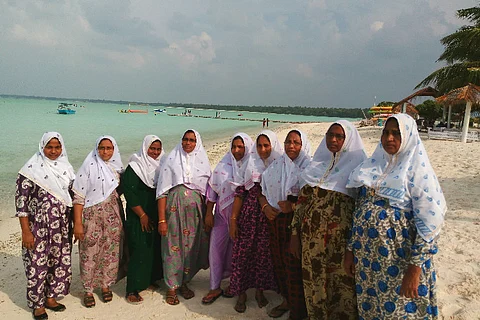

The beach is a magical place at night; and it appears even more so, when you know that the water that washes over your feet is the clearest blue in the day and brings with it many-coloured curious fish to your feet. Even more heartening, is that as a woman, you can be there, free of fear. The women of Maliku, as they call their island in Mahl, do not know such fear on their beach.
Of 10 inhabited islets of Lakshadweep – mere dots on the map of India – the Minicoy isle stands out. The island that lies 213.83 nautical miles (400 kilometres) to the west of Kochi in the Arabian Sea is known to the Lakshwadeep islanders, as the island of women.
Spread over an area of 4.8 square kilometres, this tiny isle has 10 villages, each consisting of around 100 to 150 houses, with a total population of just 10,700.
All of them speak Mahl, a dialect of the Maldivian language as the Minicoy was once part of the Maldivian kingdom, while inhabitants of the other nine isles converse in a tongue very similar to Malayalam.
What makes Minicoy more special, is that their society is matriarchal, but not just in name.
“It is the eldest woman in the family who approaches the bride’s or groom’s family with a marriage proposal, and not the men,” says Amina ‘Mooppathi’ of Sedivalu village.

The dowry system prevalent on the mainland is practised in reverse here, it is the groom who gives gifts to the bride.
“The amount of gold and other gifts is proportionate to the social and economic status of the bride and groom. To marry a girl from a middle-class family, the groom will need to gift at least 500 grams of gold, expensive new dresses, kitchen appliances, and anything else that the bride demands,” says Amina, while speaking to The News Minute.
All the daughters in the family stay together at the ancestral home, while the sons live with their in-laws.
Since the 1990s, the village elders have made it compulsory for both the bride and the groom to procure medical fitness certificates before marriage.
“They have to produce it before the religious authorities at the mosque before marriage. This practice began towards the end of the 90s, when HIV had spread to an alarming extent on the island. Hence, the need to prove that both man and woman are free of sexual diseases,” explains Amina.

Remarriage and divorce too are very common among women here.
Here, women remarry frequently….no big deal. It is not just the men, but women also have equal rights to go for talaq (divorce). Since a woman lives at her own home along with her parents and siblings, she enjoys a lot of family support,” remarks Muhammed ‘Mooppan’ of Fellisherri village.
Walking along the streets of Minicoy, one is greeted by the beautiful sight of both girls and grown-up women bicycling along the paths.
70-year old Havva who was cycling to a neighbouring village to attend a meeting, feels that in no way does a hijab impinge on her freedom.
“Many think that Muslim women do not enjoy freedom. But here in Minicoy, we enjoy freedom at its best. Women are not restricted from doing anything. She is the one who takes decisions at home, looks after everything. The men actually have a very limited role to play,” she chortles.

Havva
Most of the menfolk work in Merchant Navy ships and are at sea for close to nine months a year. Men who live on the island eke out a livelihood as fishermen, and also tend to be away from home for days together.
Havva however, rues that despite all the liberalism, the kitchen still remains a female zone. But all the men in the village have to cook at least two or three times in a year, when all the women gather at the ‘Avaruge’, (village house). The whole community gathers at the ‘Avaruge’ to celebrate, cook and eat, on all festivals days, including Independence Day and Republic Day.
These are the days women celebrate to make men aware that cooking is not just a woman’s job alone. On such days, the only thing a woman does is relax, dress up and enjoy her food. No help whatsoever is forthcoming to the men who have to handle the kitchen entirely on their own.
“Even though most of the male islanders are employed on ships, they are basically fisher-folks. So they are traditionally taught to respect the sea, right from childhood. They are also taught to treat women with the same respect they accord to the sea. That is what makes this island different from the rest,” elaborates Aysha, who runs a bike spare parts shop in Minicoy.

Aysha
“Family fights are rare, as women live in their own houses, and not with the in-laws. That is another reason that contributes to her freedom,” she adds with a smile. Any dispute is resolved by the Mooppan (headman) and Mooppathi (headwoman).
It is also a common sight to see women offering the ‘namaaz’ (Muslim prayer) on the sea-shore and on boats.
“We do not have to drape ourselves in a black ‘purdah’ all the time. When it is time for ‘namaaz’, we do not let our surroundings restrict us from offering the same. We do not have to hide ourselves inside a room,” tells Fathima ‘Mooppathi’ of Bada village.

A few mosques on the island have also opened their doors for women, wherein a separate but equal space is given to them to say their prayers.
“We also go for ladies-only picnics in small groups to other islands, or venture out for a day’s boat-ride on the sea, without any male escorts,” grins Fathima, as she glances lovingly at the sea.